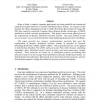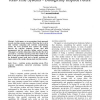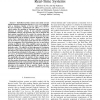109
click to vote
RTS
2006
15 years 8 days ago
2006
Many of today's complex computer applications are being modeled and constructed using the principles inherent to real-time distributed object systems. In response to this dem...
119
click to vote
ENTCS
2007
15 years 9 days ago
2007
ion and Completeness for Real-Time Maude Peter Csaba ¨Olveczky a,b and Jos´e Meseguer b a Department of Informatics, University of Oslo b Department of Computer Science, Universi...
JCP
2008
15 years 9 days ago
2008
- In this paper, we are presenting a bionic approach towards real-time systems research. Observing that a cell is both real-time computing and real-time manufacturing system, the w...
IJES
2006
15 years 10 days ago
2006
Embedded real-time systems must satisfy not only logical functional requirements but also para-functional properties such as timeliness, Quality of Service (QoS) and reliability. W...
100
Voted
FUIN
2006
15 years 10 days ago
2006
Abstract. This paper describes an attempt to combine theorem proving and model-checking to formally verify real-time systems in a discrete time setting. The Timed Automata Modeling...
116
click to vote
ENTCS
2006
15 years 10 days ago
2006
In this paper, we address the issue of the formal verification of real-time systems in the context of a preemptive scheduling policy. We propose an algorithm which computes the st...
ENTCS
2006
15 years 10 days ago
2006
We propose a format of predicate diagrams for the verification of real-time systems. We consider systems that are defined as extended timed graphs, a format that combines timed au...
90
Voted
FAC
2008
15 years 12 days ago
2008
We extend the approach of model checking parameterized networks of processes by means of network invariants to the setting of real-time systems. We introduce timed transition stru...
113
click to vote
SIGCOMM
2010
ACM
15 years 16 days ago
2010
ACM
We argue that recent hypervisor-vs-microkernel discussions completely miss the point. Fundamentally, the two classes of systems h in common, and provide similar abstractions. We a...
123
click to vote
JTRES
2010
ACM
15 years 16 days ago
2010
ACM
Chip-multiprocessors offer increased processing power at a low cost. However, in order to use them for real-time systems, tasks have to be scheduled efficiently and predictably. I...






